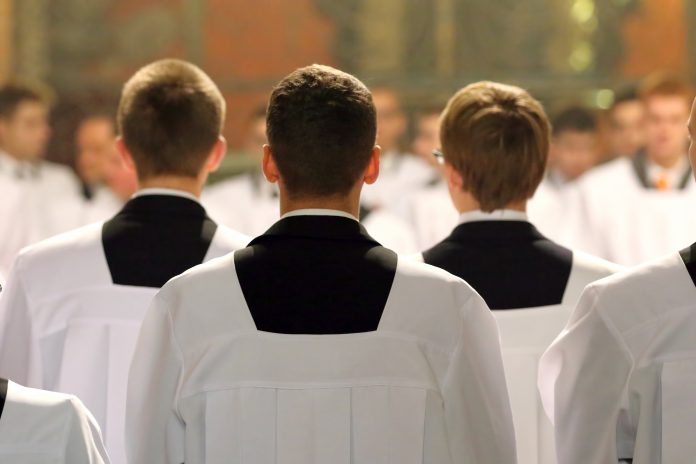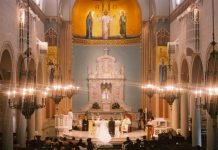
by Kate Ristow
For a Scripture research activity on Ordination, see the end of this article.
There’s almost nothing my parish loves more than a seminarian or, better yet, a seminary deacon—a man in the final phase of preparing for ordination. These men, usually young, seem to bring out the best in us.
For the past two summers, we had the privilege of having a seminarian with us participating in a “pastoral internship,” which our pastor describes as an opportunity for this young man to be active in all areas of ministry “seeking to comprehend what it means to be a priest in a very, very active suburban parish.” Our intern follows on the heels of the seminary deacon who ministered to us, and us to him, as he prepared for ordination for the Grand Rapids diocese.
Supporting Formation
It didn’t seem to matter that we’d probably never see newly ordained Father Mike again or that the people of Grand Rapids will reap the benefits of his time with us. Like the vast majority of Catholics, we love our priests and are thrilled to assist in their formation. We are also acutely aware of the priest shortage and want to do all we can to nurture and encourage young men who have heard God’s call.
As catechists, one of our responsibilities is to teach all our students about the Sacrament of Holy Orders and to invite the boys we teach to be open and responsive to that call in their own lives.
Holy Orders is one of the two Sacraments at the Service of Communion. In these two Sacraments, some members of the Church are set apart or consecrated to serve the whole Church.
Sadly, we often focus most of our attention in catechizing on the Sacrament of Matrimony, the other Sacrament at the Service of Communion. Perhaps we do this unintentionally or because we know that, of the two Sacraments, Matrimony is the one most of our students will experience as adults. Or we may shy away from teaching about Holy Orders because it is reserved for men and we’re nervous about questions or protests we’ll get from the girls in our class. It’s important that we push past these worries and help our students understand what ordained ministry is and how the Church celebrates it.
Sharing in the Priesthood of Christ
Any discussion of Holy Orders needs to be rooted in the students’ understanding of what their Baptism means. Through this Sacrament of Initiation, the “gate” to all other Sacraments, we are given a share in the common priesthood of all believers. We become a “chosen race, a royal priesthood, a holy nation, God’s own people” (Catechism of the Catholic Church, n. 1268).
Work with students to brainstorm the many different ways they can continue the work of Christ in the world through their baptismal calling. Appoint one student to act as a recorder, listing the ideas that are generated on the chalkboard or a poster.
Remind students that they received a white garment on the day of their Baptism. If possible, show them the garment that is used in celebrations of infant Baptism in your parish. Help students appreciate that the white garment is a sign that the newly baptized has been clothed in Christ.
Discuss with the class what it means to “put on Christ” as we do when we are baptized. Ask students to name specific responsibilities they have because they are baptized. Compare their ideas with the list created earlier. How are they similar? How do they differ?
Building Up the People of God
Explain to the class that the two Sacraments at the Service of Communion—Matrimony and Hoy Orders—are focused on the salvation of others, although these Sacraments also may contribute to one’s personal salvation. Point out that in Holy Orders, the mission Jesus entrusted to his Apostles continues—the proclamation of the Gospel endures, the Sacraments are celebrated, and the spiritual needs of the People of God are served.
Explain that the term order means “degree” or “rank.” Draw three intertwined rings on the board. Label the first “Deacon,” the second “Priest,” and the third “Bishop.” Explain to the class that these are the three degrees or levels of ordination. Discuss with students the responsibilities of each of these important ordained roles. (If your textbook does not cover this topic, refer to the Catechism of the Catholic Church, nos. 1554-1571 or the United States Catholic Catechism for Adults, pages 264-276.) Help students appreciate the service our ordained ministers provide to the Catholic community.
Dealing with the Tough Questions
Two issues are likely to arise in any discussion of the priesthood, especially with junior high students. Don’t duck these questions. They are like having elephants in the room. Everyone knows they are there. If you don’t acknowledge them, the kids might not hear anything else you say.
Students want to know why women can’t be ordained. An excellent treatment of this topic is found in the article titled “Who May Be Ordained?” beginning on page 267 of the United States Catholic Catechism for Adults. Use your own words to interpret this section for your students. Emphasize that women always have and continue to play a vital role in the mission of the Church and Christ’s ministry today. Invite students to name ways women serve the community in your parish. Be ready to add your own list of ministries in which women are involved.
The other issue you may get a question on is the pedophilia scandal, especially if it has severely impacted your parish or diocese. If so, you must acknowledge the reality: It is a terrible thing that some priests—very few—abused their power and that the trust that vulnerable children and teens placed in them was broken. Assure your students that our bishops are working to heal the pain that has been caused and ensure that it does not happen in the future. Urge students to pray for anyone who has been abused and to ask the Holy Spirit to inspire all those who are ordained to be examples of Christ in all they do.
Activities for Different Age Levels
* Create a poster with pictures of community helpers for primary-age students: a fireman, a nurse, a teacher, a crossing guard, the president, and so forth. Leave space for a photograph of your parish priest or an illustration of a priest taken from another source.
After the students identify how each person helps the community, ask them who helps your parish to learn how to follow Jesus. Keep giving hints until the children identify the term “priest” or name your parish priest. Then talk about the different ways priests serve the community.
Show pictures of Pope Benedict XVI and your local bishop. Briefly explain their roles. Tell the children that each of these men has received a special Sacrament called Holy Orders in which they promised to serve the Church and the People of God.
* Invite students to make a “Thank You, Father!” poster for your parish priest. Decide on a few images they want to draw on the poster to illustrate the many things the priest does in your parish. Be sure to have all students sign the poster.
* If your parish has one or more permanent deacons, invite one of them to visit your class to talk about his ministry and formation. This will work best if you work with students the week before the deacon’s visit to create a list of interview question. Encourage the deacon to keep his responses brief.
* Have older students work in small groups to identify the rewards and sacrifices they feel an individual choosing ordination would experience. Have each group compare its responses with the responses of the other groups.
* If you have a seminary in the area, invite a seminarian to visit your class to talk about his decision to seek the priesthood and the preparation involved. As an alternative, you might ask the Director of Formation at the seminary to recommend a newly ordained priest who may be available to speak to your class. Encourage the newly ordained to bring a video of his ordination to class to show and explain selected segments to the class.
* Work with students to create prayer petitions or an original prayer that you can e-mail or send via post to seminarians preparing for the priesthood to let these men know that you are praying for them. Have students create a cover letter explaining why they are sending their prayers. This outreach may result in your students—or your program—becoming “pen pals” with a seminarian and allow them to experience, vicariously, the stages a seminarian goes through on the way to ordination.
* Have older students learn more about your local bishop by locating his biography on your diocesan website. In most cases, students are also likely to find the bishop’s coat of arms, his motto, and an explanation of both. Follow up on this activity by having students write the bishop, telling him about their research and asking him to write back with a description of a typical day in the life of a bishop. Kids really have no idea what our bishops do! The kids might also do the same with your pastor. They’ll be surprised at all that is involved in being shepherd of your parish.
* Conclude any lesson on Holy Orders by reminding students that the primary sign in this Sacrament is the laying on of hands. Call attention to the fact that when we are confirmed, the bishop also lays his hands on us and prays that the gift of the Holy Spirit will be strengthened in us. Call students forward, one at a time, and extend your hands over their heads or place them on the students’ shoulders and pray, “(Name), may the Holy Spirit help you love and serve in Jesus’ name always.”
Promoting Vocations
You’ve heard it said, “If you want peace, work for justice.” A variation of this adage might be: “If you want priests, work for vocations.” Vocations don’t just happen. A spark must be lit, then kindled, before it can become a flame.
* Speak up! Notice the boys in your class who display a love for the Lord and/or leadership qualities. Mention to the youngster that you think he would make a good priest. Invite the student to pray about it.
* Remember that we all have a vocation that flows from our Baptism. Cultivate those vocations by giving students the opportunity to experience a variety of ministerial activities—both on the parish grounds and in the larger community. The list is almost endless—ushering at a children’s Mass; setting the tables at a soup kitchen; packing a holiday meal box for the poor; wrapping Christmas presents for children living in a shelter; stocking and organizing the shelves of the parish food pantry; making container planters for those who are not able to get out; preparing a song or play to perform at a senior center; and so forth. The added value of this variety is that young people almost always find a place where they “fit”—some aspect of ministry that makes them say, “Hey! I could do this when I grow up!”
* Contact your diocesan vocations office or department and inquire about the availability of appropriate resources to use with your class. You can also find vocation awareness resources to purchase by visiting the website for the National Coalition for Church Vocation (nccv-vocations.org). Your diocesan office is sure to have on hand many of the resources from NCCV—either to rent or to borrow at no charge.
* Vocation Awareness Week, which has been observed since 1976, will be celebrated January 9-17, 2010. Google the topic now and bookmark the sites that offer resources you can use with your class; there is a vast difference in what individual dioceses provide. Keep in mind that you can use these resources at any time of the year.
Kate Ristow, Contributing Editor to CATECHIST, is National Catechetical Consultant for RCL Benziger. She has been involved in children’s religious education for over 25 years as a Catholic-school teacher and parish catechist
Ordination Scripture Research Activity
Divide the class into several small groups. Selecting from the list below, assign to each group an Old Testament reading, a New Testament reading, and a Gospel reading. (These lists are taken from the “Ordination of Deacons, Priests and Bishops” from the Rites book.) Have students use Bibles to study and discuss their assigned readings and then to decide how each reading relates to the Sacrament of Holy Orders.
Readings from the Old Testament
Numbers 3:5-9
Numbers 11:11b-12, 14-17, 24-25
Isaiah 61:1-3abcd
Jeremiah 1:4-9
Readings from the New Testament
Acts 6:1-7b
Acts 8:26-40
Acts 10:37-43
Acts 20:17-18a, 28-32, 36
Romans 12:4-8
2 Corinthians 4:1-2, 5-7
2 Corinthians 5:14-20
Ephesians 4:1-7, 11-13
1 Timothy 3:8-10, 12-13
1 Timothy 4:12-16
2 Timothy 1:6-14
Hebrews 5:1-10
1 Peter 4:7b-11
1 Peter 5:1-4
Readings from the Gospels
Matthew 5:13-16
Matthew 9:35-38
Matthew 10:1-5a
Matthew 20:25b-28
Luke 10:1-9
Luke 12:35-44
Luke 22:14-20, 24-30
John 10:11-16
John 12:24-26
John 15:9-17
John 17:6, 14-19
John 20:19-23
John 21:15-17
Copyright 2010, Bayard, Inc. All rights reserved. This article is protected by United States copyright and other intellectual property laws and may not be reproduced, rewritten, distributed, redisseminated, transmitted, displayed, published or broadcast, directly or indirectly, in any medium without the prior written permission of Bayard, Inc.
This article was written by the Catechist Staff and appeared in Catechist magazine, December 2009.
Image Credit: Shutter Stock 532640554




